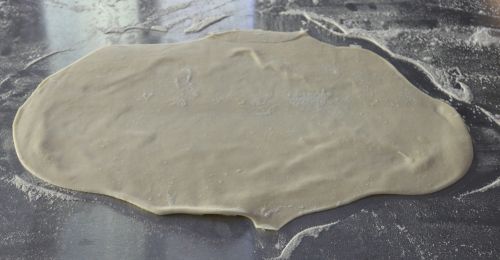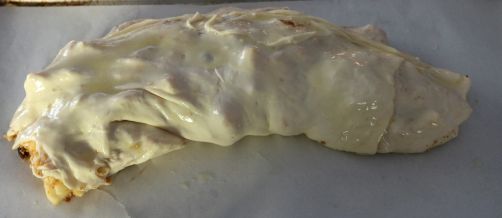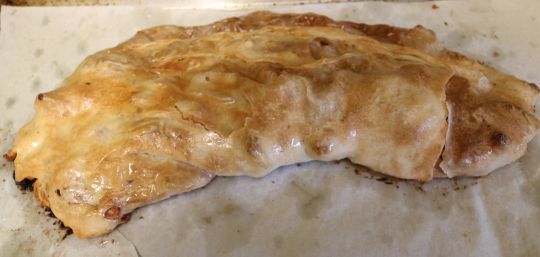Forum Replies Created
-
AuthorPosts
-
I started by rolling the dough out with a rolling pin as far as it would go:
Then I stretched it as much as I could. I think if I had used the tablecloth/bedsheet method I could probably have stretched it a little further, and it would almost certainly have made rolling it up a little easier.
Half of it gets coated with melted butter, the other half gets the toasted bread crumbs, sugar and cinnamon mix on the bottom and the apples and raisins on top of that. The sides are tucked in a little to help keep the filling from falling out.
The hardest part was rolling it up, a number of apple slices fell off the table in the process, but I did eventually get it rolled up and transferred to the baking sheet.
Attachments:
You must be logged in to view attached files.Well, it won't win any awards for best looking strudel, but boy it really smelled great while baking and the taste is excellent, too.
I'd make this again, possibly decreasing the amount of filling or increasing the amount of dough.
We got 11-12 slices, my wife's carb estimator puts it at about 20 grams of carbs per slice, which isn't bad as desserts go. (But then we had two pieces, one with ice cream.)
Strudel is often topped with powdered sugar, but I did a simple syrup glaze on it right after it came out of the oven.
The next post will have some work-in-process photos.
Attachments:
You must be logged in to view attached files.I've got several pictures, not sure how good the lighting is on them, my work table is in the basement and there are no overhead lights in that section.
The strudel is in the oven, I'll wait until it is out to post pictures.
First reaction is that the amount of dough and filling weren't in balance, maybe I didn't stretch it far enough but it was definitely thin enough to read through, and it wasn't stretching much further without tearing. It seemed like there was too much filling for the amount of dough, next time I'll be tempted to increase the amount of dough and decrease the amount of filling. (I used 2 pounds of apples before peeling and coring.)
It was quite a bit of work, but many things are a lot harder until you master the techniques. It may be a while before I try it again, it kind of depends on how we like this one and when I can get more of the right kind of apples.
I did not use the bedsheet/tablecloth method, next time I think I will, that might make rolling it up a bit easier. (Having less filling would likely help, too.)
One of the ideas for a covered container is to cover a baking sheet with a disposable aluminum foil turkey roasting pan. I haven't tried that yet. (I think you're supposed to take it off about half way through the baking time.)
That would certainly keep the drafts off the loaf before it sets up, as well as adding a bit of steam.
Aaron, have you tried asking over on the BBGA forum if anyone knows a technician who'll work on your oven?
Considering how often I mess up shaping, I have great admiration for the professionals who can do it right nearly every time.
My wife helped her mother make apple strudel dough during the preparation of the Nebraska Centennial Cookbook, which her mother edited, testing nearly every recipe. She said they used the largest table in the house and the dough nearly reached the floor anyway.
The recipe I'm planning to use (from Lil Vienna) uses just 1 cup of flour, vs the 2 1/2 cups in the recipes in Centennial Cookbook, and based on the pictures it looks like it should fit on my work table.
The had some new crop Jonagolds at the store today, they're supposed to be a good cooking apple if they're fresh (they get mushy when stored), so I may be trying something, possibly strudel dough, tomorrow.
I found a strudel recipe that looks like it will fit on my new work table.
I'm having some vision issues lately (difficulty focusing on close-up items, like books or recipes), so if I'm working from a recipe it is sometimes more of a work (and eye-strain headache) than I'm up for. I've got an eye doctor appointment scheduled, it may be time for me to have cataract surgery.
This new computer does a better job zooming in on things so I can read them, but the touchpad is so sensitive I wind up clicking on things I didn't mean to click on. I've lost a few posts that way already, and had to retype them.
Yes, that's a pre-ferment, my guess is it would be closer to a biga than a poolish, because it is pretty close to 100% hydration.
But as the articles more or less points out, in Italy any preferment is called a biga, just like in France all sourdough cultures are called levains.
Pate Fermentee sort of falls in between the cracks here. Sometimes called 'old dough', it varies from other preferments in that it often has most of the ingredients in the final dough, most notably some salt.
Salt is the friendly enemy of yeast, use enough of it and it will pretty much kill off the yeast. Salt is hygroscopic so it sucks up water that the yeast can't use to grow. (So does sugar.) But slowing down the yeast a bit can be a good thing if it allow more time for enzyme action, which breaks the complex starch in the wheat down into simpler sugars, generally maltose.
Peter Reinhart and others have written about the trade-off decisions bakers, especially commercial bakers who have a production schedule to meet, have to make, preferments trade a bit more time for more flavor. (A full-fledged sourdough starter is the ultimate preferment.)
Chad Robertson's Tartine Bakery books talk about acid balance in a sourdough, referring to the balance of lactic acid producing bacteria (LAB) and acetic acid producing bacteria (AAB). The AAB prefer colder temperatures, so if you refrigerate your starter, as most home bakers do in between baking sessions that may be a week or more apart, your sourdough is going to have more AAB and less LAB. (I have a tendency to get this backwards, but the LAB prefer higher temperatures.) Acetic acid produces a harsher more assertive sour flavor in bread.
One way around this is to prepare a young or immature starter by using only a very small amount of the mother starter culture (Robertson uses 5%) when making the levain for a batch of bread that is kept at room temperature. This way the LAB have their preferred growing conditions.
I wonder if they've changed suppliers or if someone holds a trademark on 'vermont cheese' that they have started enforcing?
My wife wants bagels for supper, so I've got bagel dough rising.
I was going to do an eye of round but both of us were feeling a bit off today, so we wound up just having oatmeal. I'll do the eye of round another time, I threw it in the freezer for now.
The Bread Lab folks at Washington State are IMHO focused more on commercial bakers than home bakers. They've got some very talented people, but this is NOT a recipe I would recommend to inexperienced bakers.
A step called 'full development' with no further detail might confuse even some experienced bakers.
We had creamed tuna on some croissants we bought at the farmer's market on Sunday. (Biscuits would have been better, we both agreed.)
-
AuthorPosts




